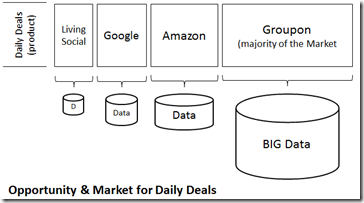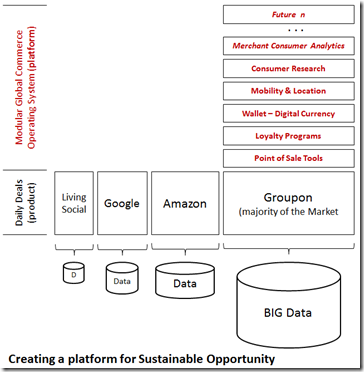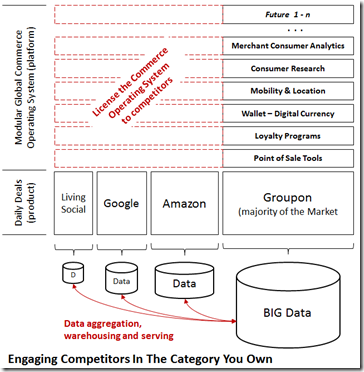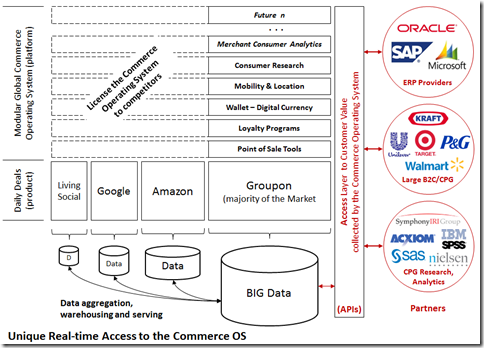 Groupon recently hinted that their business would expand well beyond daily deals, but the press and analyst communities remain narrowly focused on the company’s financial performance and alleged reporting errors. Meanwhile, I think a bold new business strategy could be developing.
Groupon recently hinted that their business would expand well beyond daily deals, but the press and analyst communities remain narrowly focused on the company’s financial performance and alleged reporting errors. Meanwhile, I think a bold new business strategy could be developing.
I’m a platforms technologist, and Groupon’s announcement started me thinking about how a system bigger than daily deals might play out. As I formed ideas into a unique, data-driven platform concept and pondered an effective business model, I began to realize the significance of its potential. My vision of a high-impact strategy may catch your imagination, too, and compel you to explore it. I hope you’ll share your ideas in the form of comments to this post for others to learn from and discuss.
Envisioning a Groupon Commerce Operating System
Daily Deals are interesting, but building an operating system for commerce that leverages global, real-time consumer and merchant data could be profoundly game-changing. Extending the concept by inviting in competitors in order to accelerate it, and opening the system to partners to build on, could set the stage for an expansive, grand unifying commerce platform that could benefit both consumers and merchants. Such a strategy could even revitalize commerce and stimulate the economy.
I wrote a few weeks ago about Jeff Holden, a Groupon executive who suggested that there was vision for such a system. Jeff was speaking to University of Illinois Executive MBA students and alumni on entrepreneurship recently at the Illini Center in Chicago. That meeting sparked the ideas presented in this article. The following is my design thinking and potential business ecosystem model for such a system.
Strap in and hold on – this post is going to scratch your brain. Perhaps it’s a platform strategy manifesto? The following might all be fiction – or not! I don’t know what is really going on so this is my own vision. The intricate and strategic complexity of the driving forces I’m going to describe require some length and explanation. I thought about splitting this into three posts…, but I think the continuity will be valuable to readers. So, here it is in one article.
Real-time Analytics as a Basis for Commerce
The unique thing is that with Groupon’s vision, there is always a flow of data. The volume of massive data is analogous to the Mississippi river flowing past St. Louis in a constant flow that can’t be stopped. It connects supply and demand ports through the exchange of value, and it is enormous enough to constantly drive upstream and downstream commerce.
The greatest value is in the dynamic flow of real-time data. This is the basis for producing statistically relevant indicators about how buyers and sellers are engaging, what type and volume of value is being exchanged, and where new opportunity is developing and when it is moving. The statically-generated rolling distribution curves generated from this massive data can cross-reference market trends, consumer buying habits, prospective buyer interests, with merchant offerings and geographic location. More specifically, this system can map the supply curve (and supply chain) to the demand curve with the third dimension of geographic location and a fourth dimension of time.
Position this type of real-time analytics system sharply against, and as having significantly more value than, traditional analytics from SAS, or SPSS (now BM) and even SAP’s analytics. The differentiation is stark. Traditional ERP analytics have a rearward-looking view of yearly, quarterly, or even monthly business data recorded in the finance department’s accounting systems. This view is not forward-looking and does not give any predictive indicators taking into account geo-location, time, consumption and supply required in today’s fast-paced socially connected and mobile consumer driven environment. Typical analytics on ERP data only tells the analyst what happened. Real-time analytics on ERP historical data is still a look backward.
In contrast, massive data-hungry predictive information engines can drive commerce in real time. New quant systems that operate in the cloud on high-performance computing system backbones can unearth opportunity before it happens, based on mood or perception analytics. Imagine the potential of such a system for both merchants and consumers.
The indicators and understanding can be found in analyzing consumer purchase habits, demand opportunity trends, merchant’s product availability in the supply chain, cross-referenced with availability in terms of location and time-to-acquire. Then, compound this potential by adding the ability of an analytics engine that can coordinate these factors and activate transactions and initiate supply-chain redirections in real time by instantly introducing and connecting buyers with the right sellers also in real-time.
This could be a profound new basis of commerce, totally unlike shipping goods up and down the Mississippi river on barges, in their tugboat driven lock-and-dam restricted supply chain.
The Value Proposition
Consumers will be connected in real-time to merchants who can satisfy their need through readily available perfect information.
The commerce system’s information is perfect because it has access to and can process massive amounts of data to generate timely and relevant indicators for decision making based on the effect of the most immediate last decision. The commerce system can do this because it is the repository for statistically relevant merchant and consumer data as the market constantly reinvents, opens and closes across global time zone cycles, validates the supply chain and consummates business decision after decision in compounding real-time.
Consumers can use these indicators to balance price, availability, intensity of (their own) demand and their willingness to satisfy their demand immediately or sometime later along a personal priority continuum that says go down the street and make a purchase (immediate), or save cost by ordering it online.
Merchants will have access to a global, flow of consumers in real time who will either buy what the merchant has to sell, or tell them what consumer sentiment wants and needs so they have an opportunity to offer it. But, most profoundly, this will produce the real-time price elasticity model that will ensure they are always selling at the price that consumers will pay.
Daily Deals – Yesterday’s Focus
Let’s look at what triggered this idea of the genesis of a global commerce operating system. In the beginning, there was interest in using smartphones as a platform for delivering coupons. Obviously, this would reduce the need to clip them and make their use more prevalent, but more importantly, it was hoped that these coupons would create a connection between consumers and merchants. The problem was, however, that not many merchant, especially smaller ones could afford to develop smartphone technology. A good platform was needed, and Daily Deals platforms popped up from Groupon, Amazon, Google, and Living Social to pursue this business.
Figure 1
It’s been an interesting journey. Starts, stops, land-grabs for the market of consumers and merchants, and the competition with parallel spaces such as loyalty programs, digital wallet, other mobile applications and even point of sale tools is all outside the immediate scope of a daily deal. I do not want to diminish its value. In a recent article by Alex Romanov in iMedia Connection presented the following data. Consider that the economy has driven the coupon redemption rate up by 16 percent. 300 billion paper coupons are printed and 3.2 billion redeemed annually with and average value of $1.65. Retail marketers are excited about digital coupon platforms.
Juniper Research measured digital coupon redemption at $5 billion in 2003 and projects it to reach 43 billion 2016. The benefits in terms of reach, simplicity and customer experience are obvious. The sustainability benefits in terms of ink and paper are also significant. Alex goes on to point out the advantages an IBM study found from proximity advertising (72% positive response rate when product is in-sight). These kinds of numbers for the initial potential of just social couponing start my platform-thinking
An unscientific assessment of the digital social coupon category might be described by figure 1, above. The most important aspect is the collection and creation of a data asset. The data asset in this limited perspective is the key to growing more consumers and merchants on the platform. The obvious thinking is to build the value proposition based on the number of consumers and merchants that your platform has as an indicator that you have best infrastructure and reach. This being proven by the size of the market measured in terms of number of customers and merchants in your database.
However, the best strategy, and I believe much larger than coupons, is to use the value of this data to open up new unique opportunity segments beyond just growing market share-shift among daily deals competitors. The principle for winning is to use data and real-time analytics to see opportunity and new markets created in real time, and then to capitalize on them.
Building a Platform of Solutions Out of a Service Product
If Groupon’s service product generates data as a by-product, what can be done with it? That is what creates the opportunity and timing to introduce the concept of a platform. A Groupon Global Commerce Operating System is a concept that builds application frameworks to add specific capability and deliver solutions to merchants that enable them to connect more intimately with their customers.
For consumers, having one trusted source for these applications makes life a lot simpler while democratizing information across merchants. It enables consumers to balance purchase decision making with criteria of cost, preferred brand, location, time-to-acquire (distance to drive) and several other potential consumer-unique decision-dependent value criteria.
Now, not only can merchants provide daily deals for their customers, they can also generate connections, strengthen loyalty and create community among a consumer base via this core value of the data asset that Groupon daily deals has generated. Merchants will be able to run their own business more efficiently, and they will have the potential ability to use a Groupon commerce operating system (platform) for point-of-sale tools, to create custom loyalty programs, to engage with digital currency, to interact on the store floor with mobile-based solutions for sharing product information and advertising, consumer research and so on.
Analytics on massive data can create opportunity on a micro-scale for generating commerce during the course of a business day. With information from the platform, price elasticity can be adjusted intra-day. During peak and slow periods of business the merchant has the tools to increase and decrease prices in order to maximize store traffic and volume throughout the day.
Avoid a Monopoly – Engage Your Competitors
Clearly you are beginning to see the elegance in this. First, you land-grab for the consumers and merchants, then you generate data – even if it costs you revenue to do it. You tune your MVP (minimum viable product) constantly to ensure that the system generating the BIG Data is robust and will maintain your share of the daily deals space.
Why this strategic move? The press and analysts are ripping Groupon for not making revenue. The competition is working to elbow their way into greater market-share of the daily deals space so as not to be an also-ran, lost and hidden in the shadow of the leader. While analysts and competitors are distracted, Groupon is focused on building the grand unifying commerce platform.
The platform enables Groupon to license the new application layers to competitors, something they want – offering access to these new tools is a strategy that will gain you access to a new source of data, making your own analytics offering richer. Merchants don’t have to change, but can participate without regretting (or being forced to change) their choice of daily deals provider. This new platform enables you to build a business model that generates revenue from multiple sources in a way that everyone benefits.
Sure, while you do this, you may not be developing the return that the observers would have you generate, nor might you be delivering the product quality both merchants and consumers are expecting. However, you are demonstrating two key things that everyone is interested in seeing. First, you are generating traction in the form of the market’s clear and growing interest in what you have to offer. Second, you are demonstrating to both merchant and consumer users that you are responding rapidly to changes to the daily deals platform, making it broader, easier, more accessible, and increasing the type and relevance of the deals offered.
Improving traction and user experience will always build momentum. Traction gains the favor of investors, and it eventually puts analysts and press at bay. Ultimately, user experiences that delight customers and increase customer retention also amplify word-of-mouth marketing lead generation. All the rest of the news is just the press, looking for the latest entertainment to offer its viewers/readers.
Platforms Always Provide Paths to More
Platform strategies are not new, but if Groupon builds this kind of infrastructure and generates a big consumer and merchant data asset from it, it will create a new industry category in which Groupon is the leader.
It will create a new opportunity for a lateral layer of analytics servicesand statistical processing in addition to raw query access to the data. This lateral layer can build a partner ecosystem to ERP (enterprise requirements planning) providers, large B2C and CPG players, and CPG Research and Business Analytics companies.
This bigger partner opportunity will be the result of Groupon’s DNA. If you have a potentially statistically relevant sample of data on consumer purchasing habits and merchant offering capability and response factors – in real time – where else can this provide value? What other institutions would like to access this data? How could this data provide value and reinvent other industries? Small merchants can’t build the platform I’ve envisioned above due to scale and core competency, and neither can larger companies in the spaces of ERP (enterprise requirements planning), Consumer Research, or large Consumer Brands and Consumer Merchants.
You might be asking yourself: “Why wouldn’t these players build it themselves?” Sure, any one of these players could build it. The resources at SAP and Microsoft seem endless. However, consumer community relationship management is just not a core competency at SAP or Oracle! The customers of SAP and Oracle are the same merchants that would want the Groupon System, but the intimate connection with the consumer that is the result of the daily deals business is missing from their makeup. That means that as a platform it is a better strategy to partner with Groupon than it is to build it. Groupon has perfected it and to catch up could require an enormous investment of time and effort.
Why Not another Daily Deals Provider
Amazon, Living Social, and Google, have the capability to build such a platform, but are focused primarily on a different market place. Google is primarily search and while successful in some new spaces, this one may be moving so fast, it will be hard to catch. Living Social may not have the idea, or has missed the narrow window of opportunity.
Amazon is a special case as an online retailer. The consumer-merchant relationship game is not the same for them, since awareness and discovery of consumer location has little value to their virtual presence. In fact, this may be the one thing that can revitalize small and medium-size local and regional merchants. It will use modern technology to revitalize and strengthen the bond between consumers and local (and smaller) merchants. At the same time, it will enable small merchants to offer better products and services through deeper understanding of the data affecting their business.
Nielsen, Acxiom, and Symphony IRI are anchored in the consumer research techniques of the past. They must create a data collection event to produce the research product they have been delivering for decades. They might need to develop and run a survey, access a panel of consumers, create a project to identify a need with each of their clients. This is not real-time. Consumer research has the opportunity to reinvent their business by licensing the Groupon Commerce Operating System as a new source of data in order to survive.
More to Ponder
How can other online environments like eBay or Craig’s List get involved? And, what about the integration of consumer-driven research and feedback from Angie’s List and even Consumer Reports?
I’ve laid out a framework in this article based on what I immediately identified as potential out of a larger platform. I’ve removed many of the buzzwords and techno-speak as well as the business and other jargon in an attempt to share enough for you to connect the dots.
I’m not a zealot about them, but Groupon does seem to have the right DNA to pull this off. It’s not an easy task, and will take significant leadership, management, innovation and ingenuity to pull it off. But it or something like it is possible.
Expect some defensive maneuvering to accommodate the accounting snafus in the press, but probably not much. While Wall Street punishes Groupon, I have to believe that something bigger is going on. We will all forget why they were punished if they pull it off. A global commerce operating system to me, sounds like the right idea.
Leave a comment; share what you think about this idea.
[Images credit: Figures Copyright Andrew Stein, Logos are trademarks of their respective owners.]














It’s called Dotomi
This is a superb concept!
There are numerous technology issues that need to be considered. The first is the concept of perfect data. The location of a consumer’s smartphone will vary considerably if one is trying to place it in conjunction with the category or clothing rack, dining area or bar area of the restaurant etc. The laws of physics make the exact location uncertain. Obviously the Nielsen, Symphony IRI and others have gotten away with imperfect (normalized data) for a long time and certainly their business models are slipping towards non-relevance.
Another technological concern is instant trend analysis in order for merchants to take advantage of a current trend or the consumer walking down the street having taken advantage of his groupon special at a hair salon or florist and now heading towards the merchant’s establishment. The merchant’s will need to have preselected their offers that could be used for this real-time event. A system that could predict for merchants what these events might entail will be wonderful yet the merchant will have to pre-load these events in order to share them with the consumers near the location.
The real-time analysis of all the relevant information mentioned may also be a privacy issue unless all consumers opt in. This may be the real sticky point.
Although possible, this concept will need to become real world in order for it to be the “next big thing” and definitely Google has far more horsepower including their recent Motorola IP acquisition which will serve to ground them in the radio frequency/cellular world.